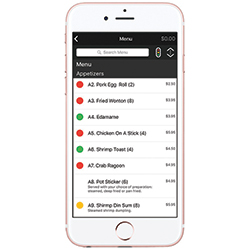Advances in technology and healthcare often overlap.
 Diet by App
Diet by App
Order Healthy has created an app with which people ordering take-out or delivery can quickly and easily compare how healthy their food choices are. Recently launched for the Phoenix area, the app gives the user access to more than 10,000 restaurants, marking each menu item with a traffic-light rating system — green being the healthiest, yellow being moderate and red being unhealthiest.
According to new research from the Perelman School of Medicine at the University of Pennsylvania, when researchers added color-coded or numeric calorie labels to online food ordering systems, the total calories ordered was reduced by about 10 percent compared to menus featuring no calorie information at all. The study is the first to evaluate the effect of “traffic-light” calorie labeling in the increasingly common setting of ordering meals online. Positive results are also supported by a study out of Harvard University entitled “Traffic-Light Labels and Choice Architecture Promote Healthy Food Choices,” which found the use of traffic-light symbols to help people make healthier choices is a good long-term solution, since people did not fatigue (revert to old choices) even after two years.
 Automation to Transform Nursing Allocation
Automation to Transform Nursing Allocation
According to an article published in Health Affairs, the U.S. healthcare industry is facing a shortage of about 260,000 nurses by 2025. Given the rise in aging population, healthcare companies are now directing their efforts to automation. Emerging technologies stand to revolutionize traditional healthcare business models, with a focus to improve delivery of services to patients. These technologies are also redefining business models within the sector, with an aim to reduce investment of resources in mundane tasks.
Intelenet Global Services, a leading Business Process Service provider, has launched Radius™, an innovative tool designed to transform the nursing allocation process in the U.S. home healthcare market. Radius, an Uber-like scheduling tool that is now being used in the healthcare sector, represents a new era of tech-powered healthcare, where definitive solutions are required to focus on specific areas within the health value chain to eliminate the corresponding challenges, such as the easing of the nursing allocation process.
While the U.S. healthcare industry is undergoing a seismic shift, vying to move from volume-centric to value-based care, effective technological enablement tools like Radius will play a key role in this transition. In the current scenario, the industry is grappling with a considerable shortage of nurses to cater to a high-demand market.













Speak Your Mind
You must be logged in to post a comment.